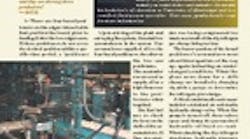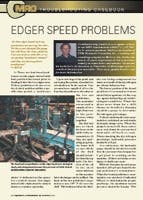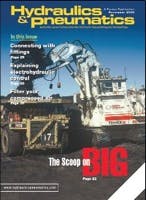With respect to the November 2006 MRO article on "Edger Speed Problems," I would like to bring the following to your attention:
1. Heat is not a reliable source for determining accumulator precharge pressure. Heat can only be generated if a gas is compressed at a rate which does not allow the heat of compression to dissipate. If the flow is relatively low, the heat gain will be marginal.
2. On-board gauges should NEVER be used to determine the energy status of a hydraulic system. Gauges become unreliable with age. Also, the location of the gauge does not necessarily reflect the presence of stored energy in a hydraulic system.
Check valves are often used to isolate accumulator circuits. With the absence of an industry design standard for pressure gauge sensing in a hydraulic circuit, the pressure gauge sensing line can be located on either side of a check valve.
If it is located between the pump and a check valve, it will naturally read 0 psi whenever the pump is idle (off). An unsuspecting person will naturally assume that if an onboard pressure gauge indicates 0 psi, then the system is safe. However, an unpredictable amount of stored energy could be "hiding" behind the check valve — its potential for inflicting severe injury or death must never be underestimated.
3. The author refers exclusively to "rule-of-thumb" for determining accumulator nitrogen pre-charge pressures without considering the machine manufacturers design specifications. Rules-of-thumb should only be used in total absence of manufacturer's specifications.
4. The pressure increase of 50 psi has little or no effect on heat, shock, or current draw from the motor. In fact, many manufacturers give pressure settings of X-psi ±50-psi.
5. It recommends checking accumulator charge pressure twice a year because of "seepage." However, you must be very careful when establishing accumulator nitrogen pre-charge intervals. Many accumulators are used for the purpose of emergency back-up power, for example, in the event of a power outage. Considering that an accumulator can be rendered inoperative by defects other than the loss of nitrogen, it is critical to service an accumulator monthly — based on an 8-hr shift.
6. These articles should include all the safety steps that one must take — for example, lockout and tagout, wearing of safety glasses — making recommendations to people who might not be qualified to do the work safely.
Rory McLaren
Fluid Power Training Institute, Midvale, Utah
[email protected]
The author responds: I thank Mr. McClaren for his input. Naturally, safety is our number one priority, and ensuring that pressure is bled down in a system that stores energy is crucial toward that end as is personal protection equipment. Experience has shown me, however, that heat is, in fact, a reliable indicator of accumulator pre-charge when used for high-flow applications.
The 350-psi pressure difference between the setting of the compensator (2950 psi) and the recommended setting (2600 psi) will have a significant effect on the heat, shock and motor current draw. I agree that, when available, the manufacturer's recommendations for all machine pressures should be followed over rules-of-thumb.



